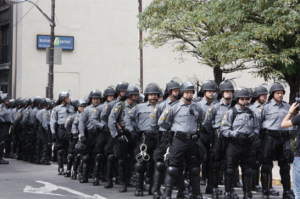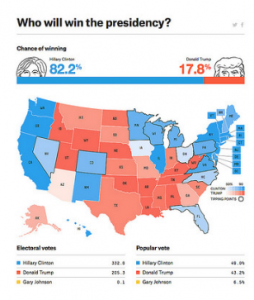A couple months back, I offered some thoughts on police violence. The most important, take-home message from that piece was that you need to be clear about what your expectations about the world are – as well as why they are that way – before you make claims of discrimination about population level data. If, for instance, you believe that men and women should be approximately equally likely to be killed by police – as both groups are approximately equal in the US population – then the information that approximately 95% or so of civilians killed by police are male might look odd to you. It means that some factors beyond simple representation in the population are responsible for determining who is likely to get shot and killed. Crucially, that gap cannot be automatically chalked up to any other particular factor by default. Just because men are overwhelmingly more likely to be killed by police, that assuredly does not mean police are biased against men and have an interest in killing them simply because of their sex.
“You can tell they just hate men; it’s so obvious”
Today, I wanted to continue on the theme from my last post and ask about what patterns of data we ought to expect with respect to police killing civilians and race. If we wanted to test the hypothesis that police killings tend to be racially-motivated (i.e., driven by anti-black prejudice), I would think we should expect a different pattern of data from the hypothesis that such killings are driven by race-neutral practices (e.g., cases in which the police are defending against perceived lethal threats, regardless of race). In this case, if police killings are driven by anti-black prejudice, we might propose the following hypothesis: all else being equal, we ought to expect white officers to kill black civilians in greater numbers than black officers. This expectation could be reasonably driven by the prospect that members of a group are less likely to be biased against their in-group than out-group members, on average (in other words, the non-fictional Clayton Bigsbys and Uncle Ruckus’s of the world ought to be rare).
If there was good evidence in favor of the racially-motivated hypothesis for police killings, there would be real implications for the trust people – especially minority groups – should put in the police, as well as for particular social reforms. By contrast, if the evidence is more consistent with the race-neutrality hypothesis, then a continuous emphasis of the importance of race could prove a red herring, distracting people from the other causes of police violence and preventing more effective interventions from being discussed. The issue is basically analogous to a doctor trying to treat an infection with a correct or incorrect diagnosis. It is unfortunate (and rather strange, frankly), then, that good data on police killings is apparently difficult to come by. One would think this is the kind of thing that people would have collected more information on, but apparently that’s not exactly the case. Thankfully, we now have some fresh data on the topic that was just published by Lott & Moody (2016).
The authors collected their own data set of police killings from 2013 to 2015 by digging through Lexis/Nexis, Google, Google Alerts, and a number of other online databases, as well as directly contacting police departments. In total, they were able to compile information on on 2,700 police killings. Compared with the FBI’s information, the authors found about 1,300 more, about 741 more than the CDC, and 18 more than the Washington Post. Importantly, the authors were also able to collect a number of other pieces of information not consistently included in the other sources, including the number of officers on the scene, their age, gender, sex, and race, among a number of other factors. In demonstrating the importance of having good data, whereas the FBI had been reporting a 6% decrease in police killings over that period, the current data actually found a 29% increase. For those curious – and this is preview of what’s to come – the largest increase was attributed to white citizens being killed (312 in 2013 up to 509 in 2015; the comparable numbers for black citizens were 198 and 257).
“Good data is important, you say?”
In general, black civilians represented 25% of those killed by police, but only 12% of the overall population. Many people take this fact to reflect racial bias, but there are other things to consider, perhaps chief among which is that the crime rates were substantially higher in black neighborhoods. The reported violent crime rates were 758 per 100,000 in cities were black citizens were killed, compared with the 480 in which white citizens were killed (the rates of murder were 11.2 and 4.6, respectively). Thus, to the extent that police are only responding to criminal activity and not race, we should expect a greater representation of the black population relative to the overall population (just like we should expect more males than females to be shot, and more young people than older ones).
Turning to the matter of whether the race of the officer mattered, data was available for 904 cases (whereas the race of all those who were killed was known). When that information was entered into a number of regressions predicting the odds of the officer killing a black suspect, it was actually the case that black officers were quite a bit more likely to have killed a black suspect than a white officer in all cases (consistent with other data I’ve talked about before). It should be noted at this point, however, that for 67% of the cases, the race of the officers was unknown, whereas only 2% of the shootings for which race is known involve a black officer. As the CIA data I mentioned earlier highlighted, this unknown factor can be a big deal; perhaps black officers are actually less likely to have shot black suspects but we just can’t see it here. Since the killings of black citizens from the unknown race group did not differ from white officers, however, it seems unlikely that white officers would end up being unusually likely to shoot black suspects. Moreover, the racial composition of the police force was unrelated to those killings.
A number of other interesting findings cropped up as well. First, there was no effect of body cameras on police killings. This might suggest that when officers do kill someone – given the extremity and possible consequences of the action – it is something they tend to undertake earnestly out of fear for their life. Consistent with that idea, the greater the number of officers on the scene, the greater the reduction in the police killing anyone (about a 14-18% decline per additional officer present). Further, white female officers (though their numbers were low in the data) were also quite a bit more likely to shoot unarmed citizens (79% more), likely as a byproduct of their reduced capabilities to prevail in a physical conflict during which their weapon might be taken or they could get killed. To the extent these shootings are being driven by legitimate fears on the parts of the officers, all this data would appear to consistently fit together.
“Unarmed” does not always equal “Not Dangerous”
In sum, there doesn’t appear to be particularly strong empirical evidence that white officers are killing black citizens at higher rates than black officers; quite the opposite, in fact. While such information might be viewed as a welcome relief, to those who have wed themselves to the idea that black populations are being targeted for lethal violence by police this data will likely be shrugged off. It will almost always be possible for someone seeking to find racism to manipulate their expectations into the world of empirical unfalsifiability. For example, given the current data of a lack of bias against black civilians by white officers, the racism hypothesis could be pushed one step back to some population-level bias whereby all officers, even black ones, are impacted by anti-black prejudice in their judgments (regardless of the department’s racial makeup, the presence of cameras, or any other such factor). It is also entirely possible that any racial biases don’t show up in the patterns of police killings, but might well show up in other patterns of less-lethal aggression or harassment. After all, there are very real consequences for killing a person – even when the killings are deemed justified and lawful – and many people would rather not subject themselves to such complications. Whatever the case, white officers do not appear unusually likely to shoot black suspects.
References: Lott, J. & Moody, C. (2016). Do white officers unfairly target black suspects? (November 15, 2016). Available at SSRN: https://ssrn.com/abstract=2870189




The hypothesis has always been that blacks are more likely to be unjustly shot because they are more likely to be stereotyped as dangerous and criminal. No one ever claimed that blacks were being shot out of KKK style anti-black animus. As such one would actually expect black officers to be just as vulnerable (true one might hope they would have non-crime interactions with black family/friends that would apply corrective force but those family/friends will likely be seen in very different contexts and with different features than the criminals they profile).
As for body cameras it is critical to state what kind of analysis says they have no effect. If all you mean is that departments that issue cameras don’t see statistical differences in racial shooting patters this tells us almost nothing. First, body cameras are often turned off or erased after the fact in dubious circumstances. Secondly, the body cameras should only affect “bad” shootings…more in second comment.
However, I think the elephant in the room here is properly defining the kind of shooting one is interested in.
The following two claims are totally consistent:
1) Blacks are no more (or even less) likely to be shot by the police once one controls for the level of violence in the area they live etc…
2) Innocent blacks are more likely to be shot by the police than innocent whites even controlling for violence level of their neighborhood.
Why? Because presumably there are many fewer police shootings of innocent people than valid police shootings. Thus, the overall figures (and any variation from the regression…non-linearity of police shootings per crime rate) will hide what is happening to the innocent.
–
Not claiming there is such a different but pointing out how important it is to be clear on what one is talking about.